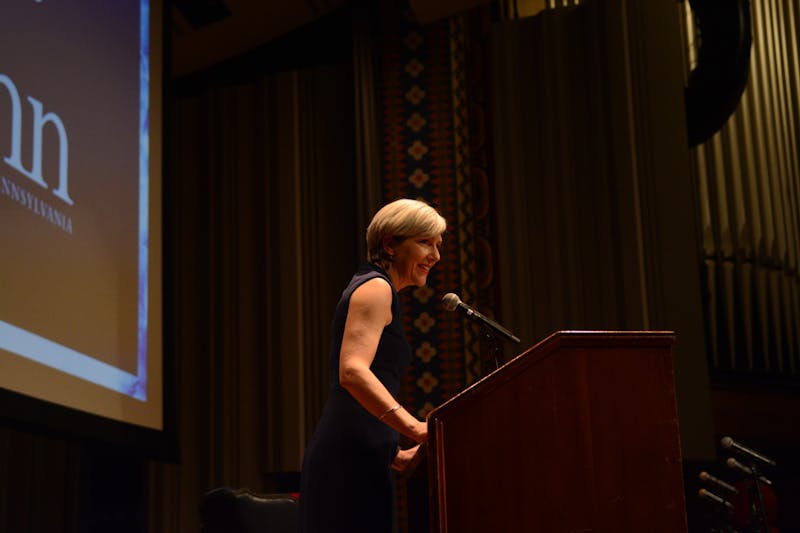
At 11 p.m. one fall night in 1979, Bob Lucid, then faculty master of Hill College House, jumped out of bed to hear a mob of voices outside his window chanting "Hill House sucks."
The voices belonged to roughly 100 Quadrangle residents who, no doubt having had a bit to drink, marched from their Spruce Street dorms down Locust Walk to Penn's second-oldest college house. They sensed that something was changing at the University, and they did not like it.
It was at this time that the idea surfaced to spread the concept behind Penn's six original, self-selecting college houses to all undergraduate dorms, creating a campus wide college house system.
Today's college house system is a program designed to fuse the academic and residential experiences of students and create distinctive communities that are more than mere dorms where students hang their coats and get some sleep.
After roughly 30 years of experiments, the college house system, as it is known today, was implemented in the fall of 1998 in an attempt to change the residential experience at Penn.
Current Penn students cannot remember a time without the college house system, as it has been in existence since this year's seniors were freshmen. So, now that the system has had time to come to fruition, The Daily Pennsylvanian decided to take a look at where the sollege souse system came from and where the system has yet to go.
And while the Quad residents in 1979 were not aware of the future of the system, they were reacting to comments Lucid had made about integrating academics into dorm life.
What ensued after the mob poured into Hill was nothing short of an all-out battle. Quad residents marched up the staircases while Hill residents flooded the college house's balconies, manned with firehoses. Water was soon everywhere, and the Quad residents were forced to retreat. But what occurred that night was something that Lucid won't soon forget.
"This group of free spirits in the Quad had sensed something, it was a sense of change in residence," said Lucid, now Gregory College House's faculty master. "This was, after all, not wrong."
In the early '70s, during a time when many students were abandoning University dorms in favor of off-campus living, some rebellious faculty members and students decided to create something different. They took over dorms, gave most of them themes and even got faculty to live in them -- and so the original college houses were born.
The Modern Language College House was a place for students to practice foreign languages, and Van Pelt College House quickly became home to many of the "free spirits" on campus. Ware College House in the Quad was flooded with pre-med students interested in participating in its "Health and Society" program.
The thing is, the students who lived in these original houses -- which also included Stouffer and DuBois -- wanted to be there.
They really wanted to be there.
And sometimes the students had to prove it. Ware's program required that students produce a project related to the house's theme during their time there. If they didn't, they were expelled.
In the early '80s, when Sheldon Hackney took over as University president, then-Vice Provost for University Life asked Lucid to head a council for the six faculty masters to promote the concept.
"We wanted to get the six houses together and start colonizing," Lucid said.
While some of the faculty masters were in favor of expanding the system, others were afraid of diluting it. The colonizers ultimately won out, and by the late '80s and early '90s, the evolutionary process was well under way.
The University was backing projects, such as adding a dining hall to the Kings Court/English House, making it into a first-year residence and adding faculty apartments to the Quad. The goal was to convert both into first-year residences.
Slowly but surely, the Quad was transformed from a dorm notorious for Spring Fling and shunning faculty to a residence that supported student-staff interaction.
But the high rises remained the bottom line of dorm options, with virtually no faculty involvement.
"It was very complicated, nobody knew what options they had," said Al Filreis, an English professor and one of the founders of Penn's college house system.
During this time, current college houses were experimenting with all types of programs, such as computing support and the implementation of residential fellows to convert dorms from mere "warehouses for sleeping" to something more.
When Judith Rodin succeeded Hackney as University president in 1994, the planning stages of the college house system got the administrative push that it needed. Rodin's ambition to become one of the top universities in the nation included the need for a top-of-the-line residential program comparable to what was offered at other Ivies, like Harvard and Yale.
"We had to deliver a residential system that could hold its head up among [the] competition just as we were trying to do so with the faculty and student body," Lucid said.
Rodin's Agenda for Excellence emphasized the undergraduate experience by focusing on the college house system, thematic hubs, such as the Kelly Writers House and Civic House, and delivering academic services to residents.
In the fall of 1997, History of Art Professor and current Director of College Houses and Academic Services David Brownlee authored the first report to actually implement the college house system, the goal of which was the "interaction of community of students, faculty and staff that extends the dimensions of time and space in which academics take place."
And so the college system as we now know it -- equipped with house deans, faculty masters, faculty fellows, computer labs and office spaces -- was born, becoming fully operational in the fall of 1998.
"The key difference is a much more faculty directed, much more intellectual presence," said Larry Moneta, former Associate Vice President for Campus Services. There is "a seamlessness between the out-of-class life of students and the academic life of students."
But the system has yet to conquer all its hurdles. The current architecture of many of the buildings on campus is not conducive to the type of community environment the college house system aims to promote. And current dining changes, such as the addition of more express meal options, have lessened the community feel in the dining halls.
"Dining is crucial," Filreis said. "You have to eat together if you want to create a community."
Filreis further stressed that the college house system needs to work to develop bonds between students and college houses that will last even after students opt to live off-camps -- a task that may prove to be a challenge.
The system needs to create "a sense that when you came through a college house, that's your community and you're forever part of that community," he said.
Although the program has experienced several milestones since its creation -- including the addition of house subsidized music lessons this year -- administrators admit the program is always looking to get better.
We're "always looking for additional things and changing to meet changing demand patterns," Brownlee said.
The Daily Pennsylvanian is an independent, student-run newspaper. Please consider making a donation to support the coverage that shapes the University. Your generosity ensures a future of strong journalism at Penn.
DonatePlease note All comments are eligible for publication in The Daily Pennsylvanian.







